Introduction:
Loose or moving flagstones that are identified during the laying process can be (and should be!) fixed there and then, but, for all sorts of unfathomable reasons, some flagstones only develop a looseness, a rocking movement, or a desire to trip up users once the pavement is well-and-truly finished, with all the jointing and bedding fully hardened and beyond a 'quick fix' rectification.
There are several alleged 'fixes' but not all are as good as they may claim to be. This page examines the hows and whys of the more popular bodg....errrr.....remedies.

The Full New Bed Method:
The only sure-fire fix for wobbly or loose flags is to lift the affected flag(s), break out the bed, put in a new full mortar bed , apply a bond bridge to the underside of the flag to be re-laid, and then put it into place. This method works, every time, no risk of it failing.
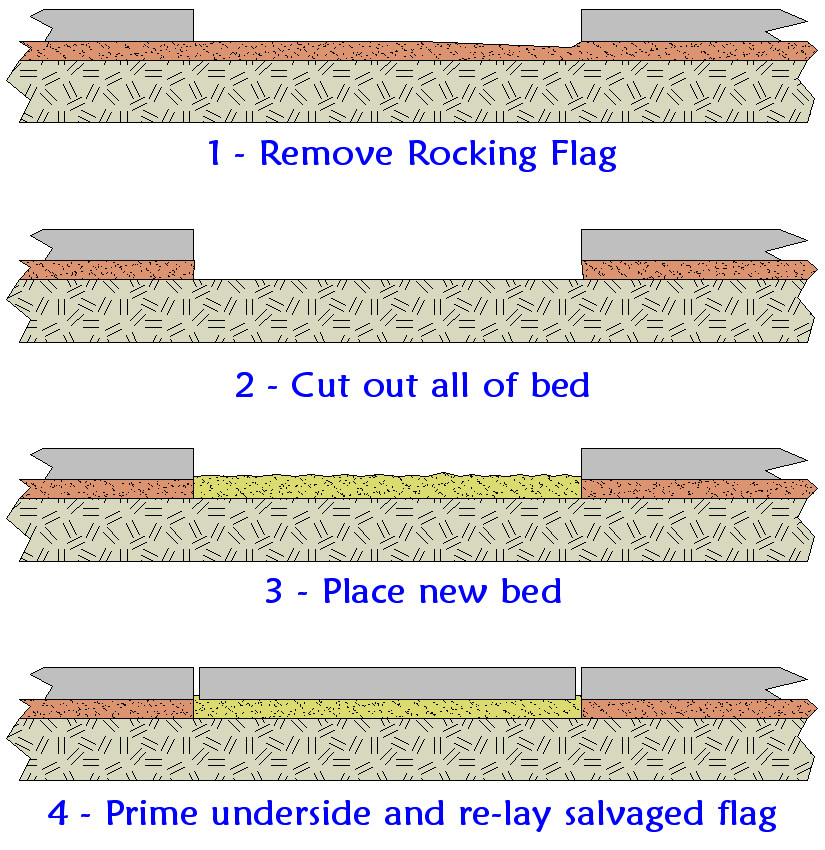
However, all that can be quite a lot of work and so there's a natural tendency to look for something a bit easier.
Let the Jointing take the strain:
One of the popular misconceptions is that re-doing the jointing will help hold the flag securely and eliminate the wobble. This rarely, if ever, works, and on the odd occasion that it appears to work, it will inevitably reveal itself to have been nothing but a temporary bodge fix.
Flags are what we refer to as "bed dependent" paving. They must have a solid and secure bed to hold them fast. Bodging the jointing does NOT provide a solid and secure bed. All the pressures and stresses and loading from users crossing over the flags is transferred to that jointing, which has a tenuous grip on the shallow edges of the flagstone, and so it's more or less bound to fail.

Pour in a slurry:
Some bright sparks don't want to go to the bother of lifting the flag(s), so they think about pouring into an empty joint a slurry of high-strength mortar, maybe with a slosh of added SBR , or a runny outdoor-grade tile adhesive. The flag is then deliberately 'rocked' to draw in the slurry to flood any minor voids within the bedding, and then allowed to set or cure. It doesn't always work, but when it does, it is perfectly acceptable as a technique and will provide the stability necessary for good paving.
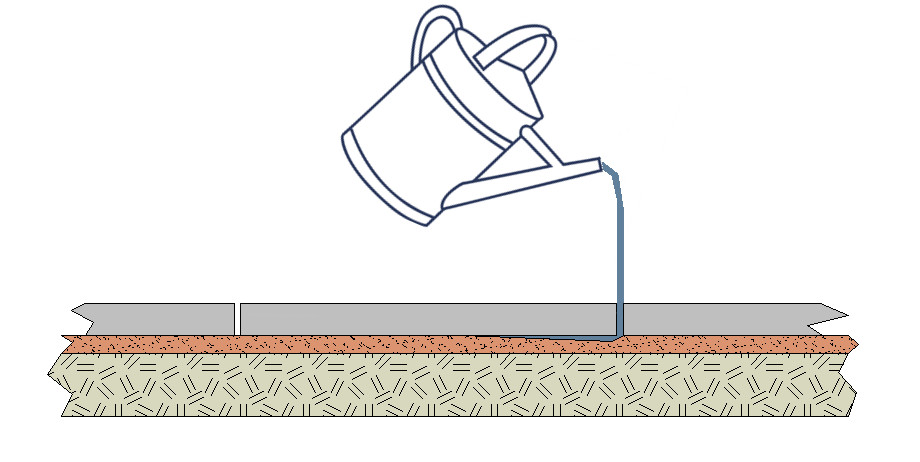
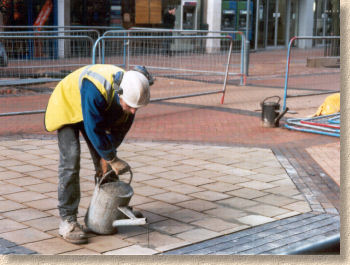
It has to be noted that the slurry must be a good quality hydraulically bound (cementitious) product, such as a 1:1 mix of fine sand with OPC plus SBR, a proprietary pavement bedding mortar, or a good quality outdoor grade tile grout. The use of unbound materials, such as Kiln Dried Sand, would not be acceptable as it is not bound and is therefore liable to be washed out over time.
Exceptional cleanliness is required otherwise the slurry can (and usually does) cause irreversible staining on the surface of the flag, and so this is a method best left to those with some experience of paving, or for those situations where aesthetics is not the highest priority.
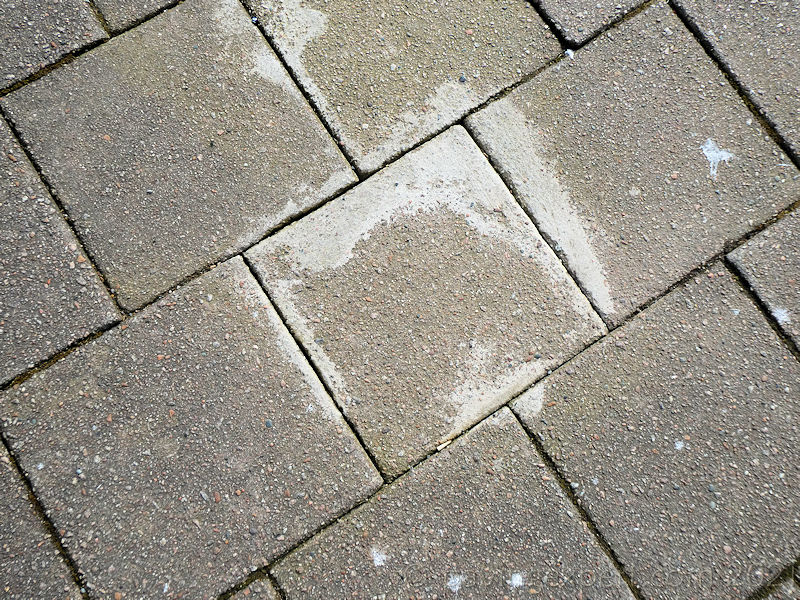
Glueing it down:
Some consider just lifting the flag off the existing bed, daubing the underside of the flag and/or the exposed bed with SBR, a bond bridge slurry, or other primer, and then sitting the flag back on to the original bed, allowing the slurry/primer to create a solid and secure bond.
The problem with this methodology is that there's a risk the bed wasn't actually correct in the first place so 'glueing down' the flag onto an imperfect bed may not fully resolve the situation.
And then there's the problem of ensuring the existing bed is spotlessly clean and free from any extraneous grit or detritus. It only takes one stray speck of grit, and the flag will rock, and that could well prevent the slurry/primer creating the desired full bond between flag and bed.

Finally, even if the slurry/primer is kept to just a single millimetre thickness, there is a risk that a lip will be formed between the 'fixed' flag and its immediate neighbours. Yes: if a simple SBR-only primer is used, any 'lifting' of the flag level will be practically zero, but this needs an absolutely clean and grit/dust free bed to start with.
Best results using this method usually come about when a slurry of 1-2mm thickness is used, and that, inevitably, means a lifting of 1-2mm in the finished level of the flag. While this might not be of much consequence on some forms of flagstone paving (say riven stone ) it can stand out like the proverbial sore thumb with other types ( porcelain being a prime example).
Glueing it - literally!
Site reader, Lee G, took this idea far more literally than origoinally intended and did just that: he glued the flagstones back onto the bed using a high strength 'Sod Nails' type product.
You can follow the full story through his posts the the Brew Cabin discussion forum on this website.
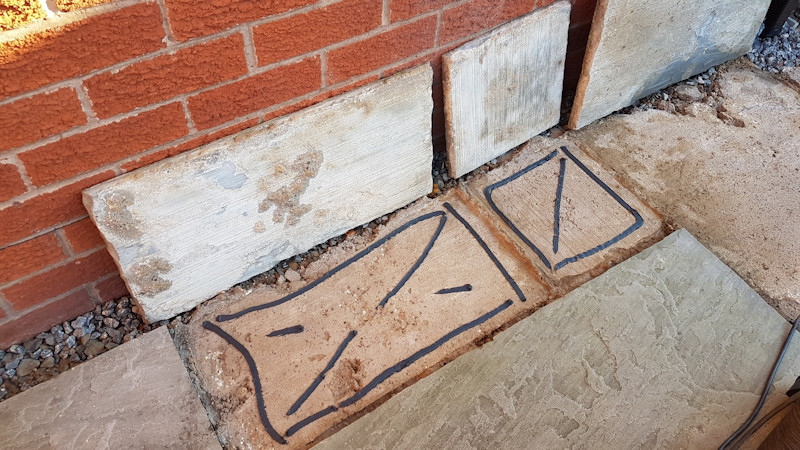
Shaving the bed:
And then there's the idea that it might be easier to chisel off a few millimetres of the original bed, add a bit of fresh mortar and then re-seat the flag.
What sounds like an excellent idea has a couple of drawbacks. Firstly, chiselling off a few millimetres is often more difficult and requires more finesse than would wholesale breaking out of the old bed.
The usual technique involves repeatedly 'scoring' the bed with a cut-off saw or angle grinder to a depth of 6-10mm or so, and then chiselling off between the shallow cuts. It's actually easier just to saw right through the bed at all four edges and then use brute force, aided and abetted by a lump hammer, crowbar or other heavy kit, to break out the entire bed.
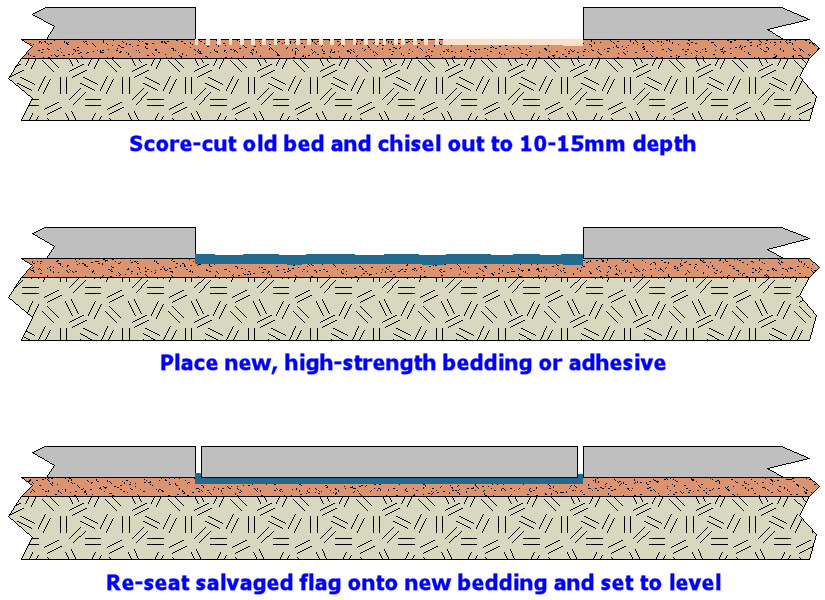
Secondly, having a relatively shallow bed onto which the flag will be re-seated can make it awkward to get the exact degree of compaction to ensure the flag is flush with its neighbours, but there's also the problem of a shallow bed not having the internal strength to prevent it cracking and/or breaking up once the flag is in place. Strengthening additives can beaded to the bedding mortar, and the receiving bed can be pre-wetted to minimise loss of essential moisture from the fresh mortar, but any mortar of less than about 12mm thickness can end up being fragile and weak.
So: is it worth all that effort in trimming and chiselling when a simple whole bed replacement is probably easier and much more likely to secure a good result?
You decide!
